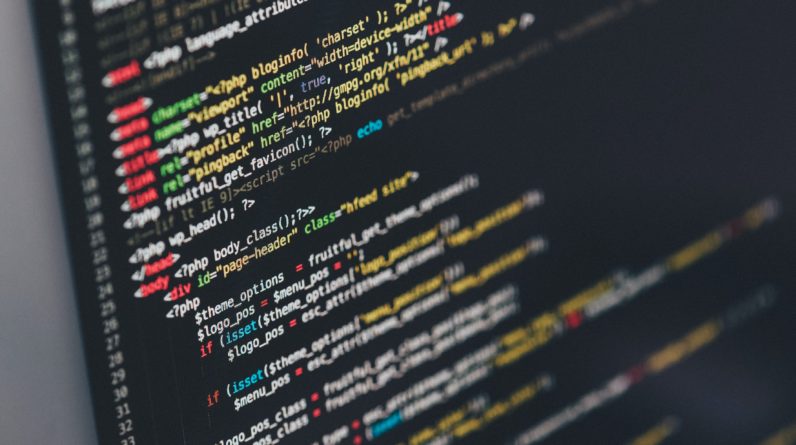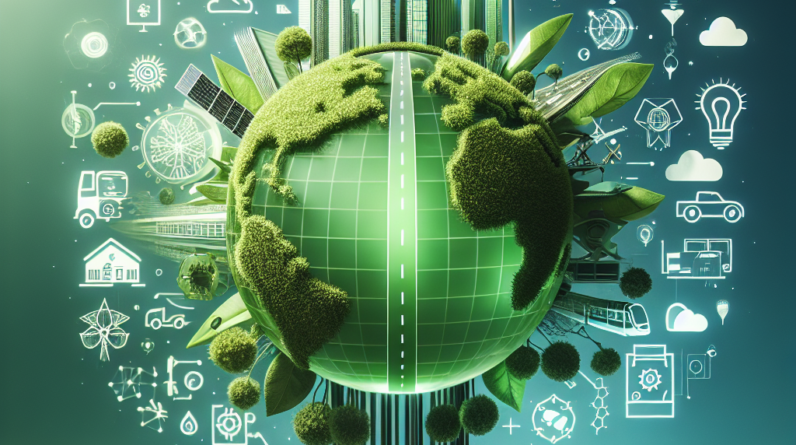
Exploring The Top Tech Trends Of 2024
In this article, you’ll get a sneak peek into the exciting world of technology and discover the top trends that are set to shape our future in the year 2024. From artificial intelligence to virtual reality, these advancements are revolutionizing the way we live, work, and play. Join us on this captivating journey as we explore the innovative technologies that are on the horizon and gain insight into how they will impact our daily lives. So, fasten your seatbelt and get ready to embark on an adventure into the future of tech!

1. Artificial Intelligence (AI)
Artificial Intelligence (AI) is a groundbreaking technology that is revolutionizing various industries. The field of AI encompasses a wide range of subfields, such as Machine Learning, Natural Language Processing, and Computer Vision.
1.1 Machine Learning
Machine Learning is a branch of AI that focuses on enabling computers to learn and improve from data without being explicitly programmed. This technology allows machines to analyze large amounts of data, recognize patterns, and make predictions or decisions based on the information learned. Machine Learning has numerous applications, including fraud detection, recommendation systems, and predictive analytics.
1.2 Natural Language Processing
Natural Language Processing (NLP) enables computers to understand, interpret, and generate human language. NLP algorithms are designed to analyze and process text or speech, allowing machines to perform tasks such as language translation, sentiment analysis, and voice recognition. This technology has significant implications for improving communication between humans and machines, as well as enhancing search engines and virtual assistants.
1.3 Computer Vision
Computer Vision involves teaching computers to see and understand visual information, similar to how humans perceive and interpret images or videos. This field utilizes advanced algorithms and deep learning models to enable machines to identify objects, recognize faces, and even detect emotions. Computer Vision finds applications in various domains, including autonomous vehicles, surveillance systems, and medical imaging diagnostics.
2. Internet of Things (IoT)
The Internet of Things (IoT) refers to a vast network of interconnected devices, vehicles, and objects that can share data and communicate with each other through the internet. This technology has the potential to transform our everyday lives and revolutionize industries.
2.1 Smart Homes
One of the most prominent applications of IoT is in smart homes. Connected devices and appliances in a smart home can communicate with each other, offering convenience, efficiency, and improved energy management. For example, you can control your lights, thermostat, and security system remotely through your smartphone or employ voice commands through virtual assistants like Amazon’s Alexa or Google Assistant.
2.2 Healthcare Applications
IoT has the power to revolutionize the healthcare industry by enhancing patient care, improving diagnostics, and streamlining operations. Connected medical devices and wearables can continuously monitor vital signs, track medication adherence, and transmit real-time data to healthcare providers. This enables remote patient monitoring, early detection of health issues, and personalized treatment plans.
2.3 Industrial Automation
IoT plays a crucial role in industrial automation by connecting machines, sensors, and systems to streamline manufacturing processes and improve efficiency. With IoT, manufacturers can monitor equipment performance, track inventory, and optimize production schedules in real-time. This technology also enables predictive maintenance, preventing costly equipment breakdowns and reducing downtime.
3. Virtual Reality (VR)
Virtual Reality (VR) is an immersive technology that allows users to experience and interact with computer-generated environments. This technology has gained significant popularity in recent years and has applications in various fields.
3.1 Gaming and Entertainment
VR has transformed the gaming and entertainment industry by providing users with a completely immersive and interactive experience. Players can step into virtual worlds and engage with the game environment, enhancing the level of realism and engagement. Virtual reality headsets and controllers allow users to interact with objects and characters in a virtual space, creating a truly unique gaming experience.
3.2 Training and Education
Virtual Reality has the potential to revolutionize training and education by offering realistic and immersive learning experiences. For example, in medical training, VR can simulate complex surgical procedures, allowing medical professionals to practice in a safe environment. Similarly, VR can be used to create immersive historical or cultural experiences, enhancing the learning process and making it more engaging for students.
3.3 Architecture and Design
VR is also being utilized in architecture and design to create virtual walkthroughs of buildings and spaces. Architects and designers can use VR to visualize and present designs, allowing clients to experience and provide feedback in a more immersive manner. This technology enables stakeholders to make informed decisions about aesthetics, functionality, and spatial relationships, ultimately improving the design process.
4. Augmented Reality (AR)
Augmented Reality (AR) is a technology that overlays digital information or virtual objects onto the real world. Unlike VR, which replaces the real world with a virtual environment, AR enhances our perception of reality by adding computer-generated elements.
4.1 Retail and E-Commerce
AR has the potential to transform the retail and e-commerce industry by providing customers with interactive and personalized shopping experiences. With AR, customers can try on virtual clothes or accessories, visualize furniture in their homes, or explore products in a virtual environment. This technology enhances customer engagement, reduces return rates, and increases conversion rates.
AR is revolutionizing navigation and travel by providing users with real-time information and guidance in their surroundings. Mobile applications equipped with AR technology can overlay directions, points of interest, and real-time data onto the user’s camera feed, simplifying navigation and enhancing the travel experience. This technology can also offer context-specific information about landmarks, historical sites, or cultural events.
4.3 Manufacturing and Maintenance
AR is finding applications in manufacturing and maintenance by providing technicians with real-time information and visual aids. AR smart glasses can overlay relevant data, diagrams, or instructions directly onto the technician’s field of vision, reducing errors and improving efficiency. This technology enables rapid troubleshooting, remote assistance, and reduces the need for extensive training.

5. 5G Technology
5G Technology is the next generation of wireless communication networks and promises to deliver faster speeds, lower latency, and increased connectivity. This technology has the potential to transform various industries and facilitate the development of other emerging technologies.
5.1 Faster Connectivity and Data Transfer
One of the key benefits of 5G technology is its ability to provide significantly faster download and upload speeds compared to previous generations. This enables the seamless streaming of high-quality video content, faster file transfers, and improved overall internet connectivity. This enhanced speed and bandwidth facilitate the efficient use of other emerging technologies, such as AI and IoT.
5.2 Enhanced Mobile Experience
With 5G, mobile users will experience improved network reliability, reduced latency, and decreased network congestion. This translates into smoother video calls, faster web browsing, and an overall enhanced mobile experience. The increased capacity of 5G networks also allows for a greater number of devices to connect simultaneously, supporting the proliferation of IoT devices and applications.
5.3 Internet of Things (IoT) Expansion
The introduction of 5G technology paves the way for the expansion of IoT applications and services. The higher bandwidth and lower latency offered by 5G networks enable real-time communication, making it easier to connect and manage a vast number of IoT devices simultaneously. This technology allows for more advanced and complex IoT implementations, such as smart cities, autonomous vehicles, and industrial automation.
6. Blockchain
Blockchain is a decentralized and distributed ledger technology that has gained prominence with the rise of cryptocurrencies like Bitcoin. However, the potential applications of blockchain technology extend far beyond digital currencies.
6.1 Cryptocurrencies and Digital Payments
One of the primary applications of blockchain technology is in the realm of cryptocurrencies and digital payments. Blockchain provides a secure and transparent way to record transactions, ensuring trust and eliminating the need for intermediaries such as banks. This technology enables faster and cheaper cross-border transactions, improves financial inclusivity, and reduces the risk of fraud.
6.2 Supply Chain Management
Blockchain has the potential to revolutionize supply chain management by providing transparency, traceability, and security throughout the entire supply chain. By immutably recording every transaction and movement of goods, blockchain enables businesses to track products from the source to the end consumer, ensuring authenticity and reducing counterfeiting. This technology also simplifies the verification of compliance with regulations and standards.
6.3 Healthcare Data Security
In the healthcare industry, blockchain technology can enhance the security and privacy of sensitive patient data. By encrypting and decentralizing healthcare records, blockchain ensures that patient information remains secure and can only be accessed by authorized parties. This technology also simplifies data sharing between healthcare providers, improving care coordination and enabling better patient outcomes.

7. Autonomous Vehicles
Autonomous Vehicles, also known as self-driving cars, are poised to revolutionize transportation by eliminating the need for human drivers. This technology has the potential to improve road safety, reduce traffic congestion, and increase transportation efficiency.
7.1 Self-Driving Cars
Self-driving cars utilize a combination of sensors, cameras, and advanced AI algorithms to navigate and operate without human intervention. These vehicles can analyze their surroundings, detect obstacles, and make informed decisions in real-time. Self-driving cars have the potential to reduce accidents caused by human error, increase fuel efficiency, and provide mobility solutions to individuals who are unable to drive.
7.2 Delivery Drones
Autonomous drones are being developed for the delivery of goods, transforming the logistics industry. These drones can navigate autonomously, avoiding obstacles and delivering packages directly to recipients, reducing delivery times and costs. Delivery drones have the potential to revolutionize the e-commerce industry by providing efficient and rapid delivery services, particularly in remote or congested areas.
7.3 Public Transportation
Autonomous vehicles are also likely to transform public transportation systems. Shared autonomous taxis and buses can optimize routes, reduce congestion, and improve accessibility, especially in urban areas. These vehicles can provide efficient transportation services, reducing the need for personal vehicles and the associated environmental impact.
8. Robotics
Robotics is a multidisciplinary field that merges AI, automation, and engineering to design and develop intelligent machines capable of performing tasks autonomously. Robotics has applications in various sectors, including industrial automation, healthcare, and agriculture.
8.1 Industrial Automation
Industrial robots are being increasingly utilized to automate manufacturing processes. These robots can perform repetitive and physically demanding tasks with precision and speed, improving productivity and reducing costs. Industrial automation robots can help streamline production lines, handle hazardous substances, and enhance overall operational efficiency.
8.2 Healthcare and Elderly Care
Robots are finding applications in the healthcare industry, assisting in various tasks such as surgical procedures, patient monitoring, and rehabilitation therapy. These robots can improve surgical precision, allow for remote patient monitoring, and assist in the care of elderly or disabled individuals. Robotic devices can provide support and companionship, enhancing the quality of life for those in need.
8.3 Agriculture and Farming
Agricultural robots have the potential to revolutionize the farming industry by increasing efficiency and productivity. These robots can perform tasks such as planting, harvesting, and pest control with precision and accuracy. Agricultural robots enable more sustainable farming practices, reduce the need for manual labor, and help address labor shortages in rural areas.

9. Quantum Computing
Quantum Computing is an emerging field that leverages the principles of quantum mechanics to perform computations that surpass the capabilities of classical computers. Quantum computers have the potential to solve complex problems and perform calculations at an unprecedented speed and scale.
9.1 Breakthroughs in Scientific Research
Quantum computing has the potential to drive breakthroughs in scientific research by enabling simulations of complex systems and accelerating the discovery of new materials. Quantum simulations can provide insights into the behavior of molecules, proteins, and other atomic-scale structures, aiding in drug discovery, optimizing renewable energy systems, and solving optimization problems in various fields.
9.2 Advanced Data Encryption
One of the most promising applications of quantum computing is in the field of data encryption. Quantum computers have the potential to break current encryption algorithms, posing a threat to sensitive information. However, quantum cryptography offers a solution by leveraging the principles of quantum mechanics to develop secure encryption methods that are resistant to attacks from quantum computers.
9.3 Optimization and Simulation
Quantum computing has the potential to revolutionize optimization and simulation algorithms, enabling businesses to solve complex problems more efficiently. Quantum algorithms can optimize supply chains, financial portfolios, and traffic flow, among other applications. These technologies have the potential to transform industries by achieving solutions that were previously out of reach for classical computers.
10. Cybersecurity
In an increasingly digital world, cybersecurity has become a pressing concern. As technology continues to advance, so does the complexity and sophistication of cyber threats. Organizations and individuals must take measures to protect their sensitive data and ensure the integrity and privacy of digital systems.
10.1 Threat Detection and Prevention
With the rise of AI and machine learning, cybersecurity can leverage these technologies to detect and prevent cyber threats. AI algorithms can analyze massive amounts of data, identify patterns, and detect anomalies that may indicate a potential cyber attack. These technologies enhance threat detection capabilities and enable proactive measures to protect against evolving cyber threats.
10.2 Data Privacy and Regulation
As the collection and usage of personal data increases, the protection of data privacy has become crucial. Stricter regulations and policies are being implemented to ensure the secure handling of personal information. Organizations are adopting measures such as encryption, secure data storage, and access controls to protect sensitive data and comply with privacy regulations, such as the General Data Protection Regulation (GDPR).
10.3 Biometric Authentication
Biometric authentication methods, such as fingerprint or facial recognition, offer enhanced security compared to traditional password-based systems. These authentication techniques utilize unique biological features to verify the identity of individuals, reducing the risk of unauthorized access. Biometric authentication is becoming increasingly prevalent in various sectors, including banking, healthcare, and government services.
In conclusion, the top tech trends for 2024 are shaping a future that is increasingly connected, intelligent, and innovative. From AI and IoT to VR and AR, these technologies have the potential to revolutionize industries and transform the way we live and work. The advancements in 5G, blockchain, autonomous vehicles, robotics, quantum computing, and cybersecurity offer unprecedented opportunities and challenges. As these emerging technologies continue to evolve, it is crucial to stay informed and embrace the possibilities they present for a brighter future.






